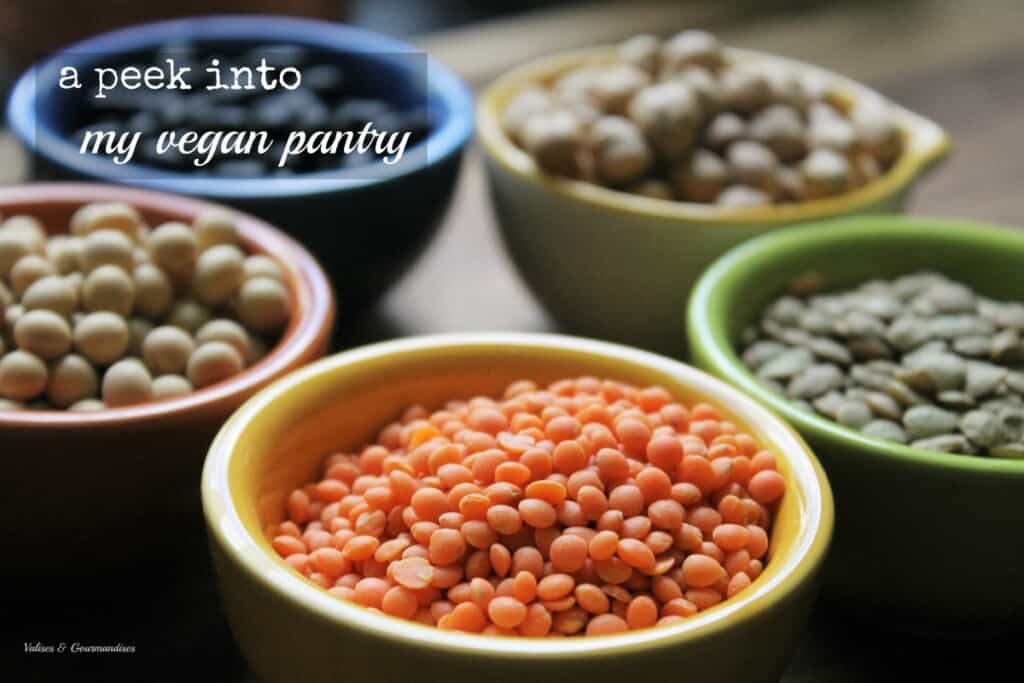
I stopped counting the Google searches I had to do because I didn’t know an ingredient in a recipe. So that’s why I thought I’d save you some frustrations and incomprehension and write up a list of what you can usually find in my pantry.
Keep in mind that I’m not a nutritionist. However the info I’m sharing comes from many hours spent reading books, articles, watching documentaries, etc. I realized during my research that there is no single miracle ingredient, but that it’s by combining all those healthy foods that we can achieve optimum health. I strongly encourage you to do your own research and to choose reliable sources. Enjoy!
Super seeds
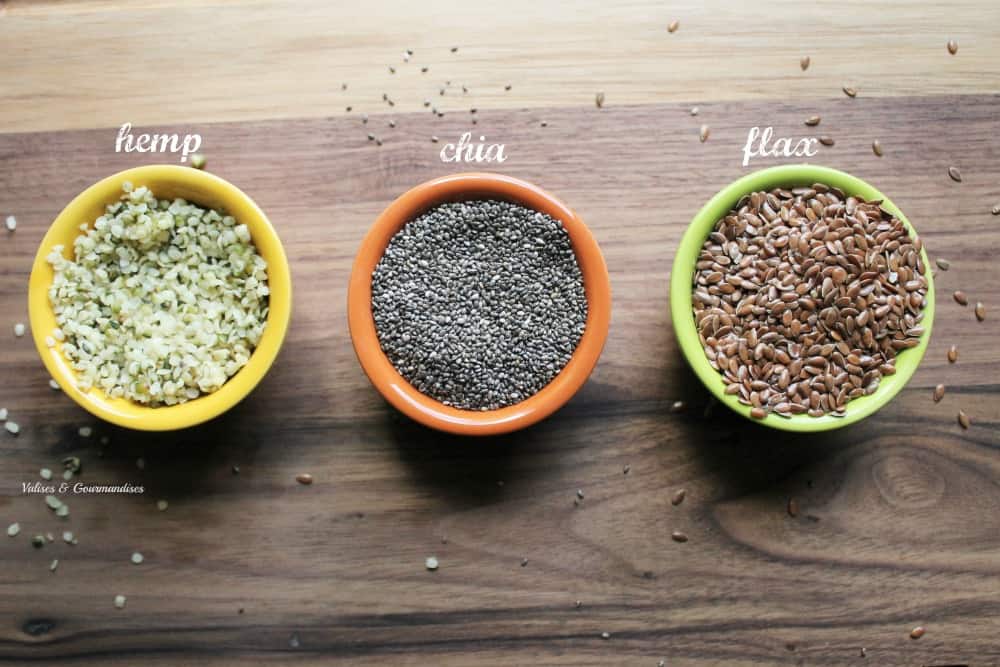
Flax seeds should be in every pantry; they’re high in fiber and omega 3 and they’re very beneficial to one’s global health. You pay the high price for omega-3 eggs? They probably simply come from a chick that was fed flax seeds… so why not leave the cute chicks alone and eat this tiny miracle seeds directly? Plus, they’re so cheap that they’re perfect for smaller budgets, just what we like!
How to use them: since they’re pretty tough, the only way to absorb their nutrients is to grind them first. Add a spoonful to your smoothies, your oatmeal, your cereals, your pastries, etc. Beside their various uses, I love them because they can replace eggs in baking; simply mix a tablespoon of ground flax seeds with 3 tablespoons of warm water, let sit for a few minutes, and voilà, you’ve got a cruelty-free/cholesterol-free “egg” that will help your recipes hold together.
A little pricier than flax seeds, these pretty Mexican seeds, which were popular among Aztecs and Mayas, are worth their weight in gold. They’re high in omega 3, fiber and calcium and, amongst others, they’re said to help regulate blood sugar and digestion. They’re so versatile that I couldn’t live without them. And did I mention their super power? Yes, they have one! They can absorb ten times their weight in liquid and transform any plant-based milk in pudding. We can also use them to replace eggs in baking, but I prefer using flax meal for this.
How to use them: make breakfast puddings, jam, pulse them into a powder to replace eggs in your French toast batter, add them to smoothies, cereals, oatmeal…
Hemp as in… marijuana? Humm, yes and no. Fear not (or don’t be disappointed, I ain’t judging), hemp seeds do not contain THC and do not cause euphoria.
They are high in good omega 3 and 6 fats, in fiber, and for those worrying about proteins, they contain all the essential amino acids and are therefore a complete protein. They are said to reduce bad cholesterol, to prevent cardiovascular diseases and to strengthen the immune system while providing energy.
How to use them: since they don’t really have any flavour, you can add them anywhere. Sprinkle them on your salads, add them to your sandwiches, smoothies, cereals, make milk out of them. They’re perfect for those gym lovers out there. Don’t look at me!
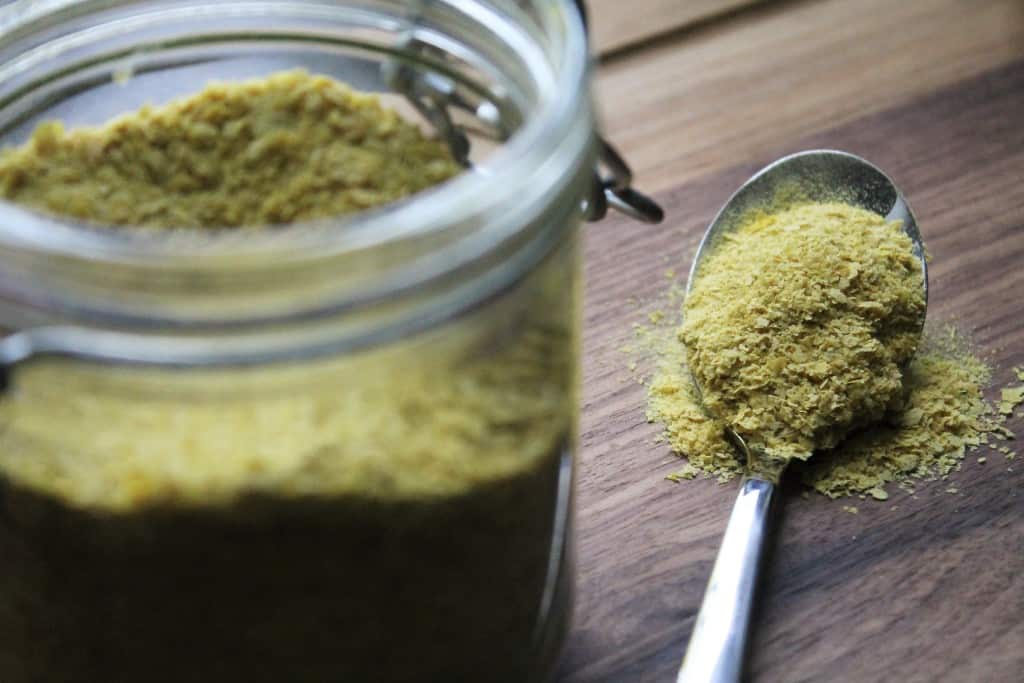
How to use it: everywhere! Sprinkle it on popcorn, pasta, add it to sauces, use it to make raw “parmesan”, vegan chicken bouillon powder, add it to your plant-based cheeses and sour creams… go crazy!
Plant-based milk
In this department, the options are endless: soy, almond, hazelnut, coconut, oat, hemp… plain, vanilla, cappuccino, chocolate…
My only advice is to go for plain organic milks with the shortest ingredient list possible. It’s best to keep those flavoured milks for special occasions, or even better, to make them yourself! Companies are very creative when it comes to the variety of weird ingredients they add to our food… That being said, it’s best to choose milks that are fortified in vitamin B12 and D.
How to use them: Unsweetened milks can replace cow’s milk in most recipes, from buttermilk to Alfredo sauce and pastries. You can even buy cream substitutes, my favourite being oat (especially in coffee). Don’t be afraid and try different brands and find the ones that you like. It’s good to note that almond milk, though super delicious, tends to curdle in coffee, which can be a little bit annoying.
You can also make your own nut milk. I show you how to make hazelnut milk here.
Yogurt
In Germany, I’m lucky to have access to the best plain soy yogurt ever, but depending on where you live, you’ll have more or less choice. Try the different brands and flavours available at the grocery store or in health food stores (usually made with soy, coconut or nut milk), or make it yourself! I plan on exploring a few recipes, I’ll let you know how it goes!
Legumes
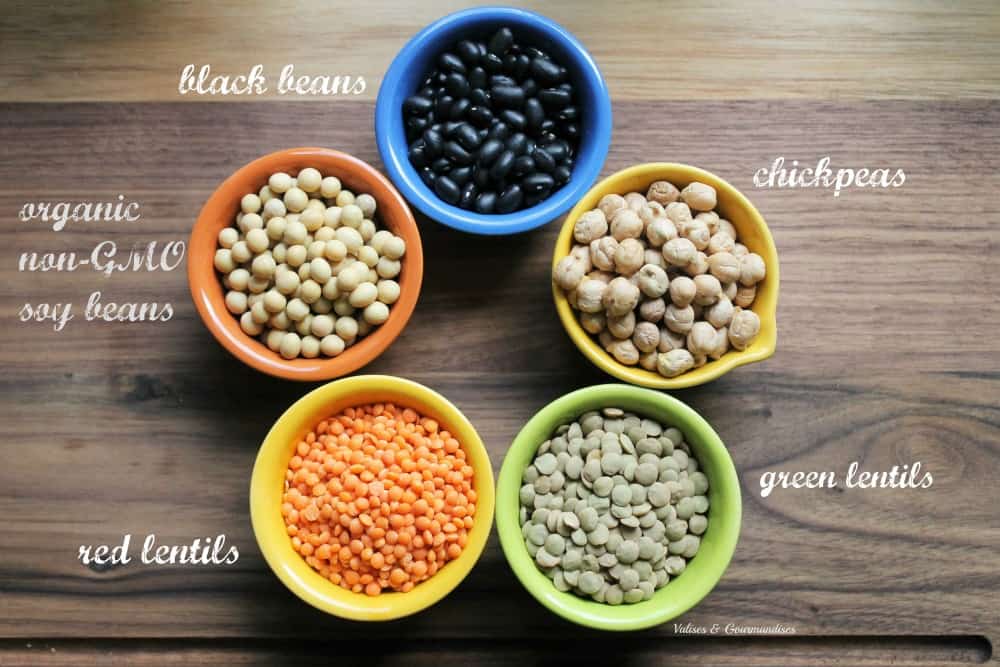
About two years ago, I couldn’t bare the sight of chickpeas, except in hummus. I use to remove every single one of the kidney beans from my mamie’s minestrone. Seriously, I just couldn’t eat beans. But by starting with lentils and adding small quantities of legumes to salads, soups and to rice, I started genuinely liking them and I now love including them on the menu. Who’d have thought!
I like to keep canned chickpeas, lentils and beans in my pantry. Since they’re already cooked, they can be used for impromptu cooking. They can also be eaten without being cooked again, in a salad for example. Once again, check the ingredient list first, especially the sodium content.
I also keep a vast array of dried beans, which require a bit more planning since you need to soak them for about 12 hours before cooking them for about 1.5 hours. When you eat a lot, dried varieties are usually way more affordable.
How to use them: Just rinse them very well and add them to a chili, a curry, a salad, use them to make hummus, sandwich spreads, or purée them and add them to pastries! You can also sprout them for a few days them to boost their nutritive content.
Grains and cereals
We’ve all heard about quinoa’s numerous health benefits, but it’s unfortunately not the most ethical grain out there. Because of the fast rise of the demand from Western countries, the local price went up too, which means that many locals in Bolivia and Peru can no longer eat it. The environmental impacts are also important. I recommend this article to understand the matter better. So I do consume quinoa on occasion because it’s so yummy and nutritious, but I really try not to eat it every week and to buy it fair trade and organic.
In this category, there’s also the traditional rice (preferably brown or basmati, fair trade if possible!) but why not shake things up and find new cereals and grains to add to your diet? Couscous, millet, amaranth, barley, bulgur, buckwheat and spelt are all delicious and nutritions options!
We can also find most of them puffed or in flakes, which make great porridge and can be added to muffins.
Since you probably know many of the cereals I mentioned, I’ll just focus on two I discovered since transitioning to vegetarianism.
First, buckwheat. There’s a festival in Québec devoted to it, but except for the occasional “galette”, which I used to despise, we don’t really eat buckwheat. I’ve learned to appreciate it and a quick overview of the blog will show you how much I actually love it now!
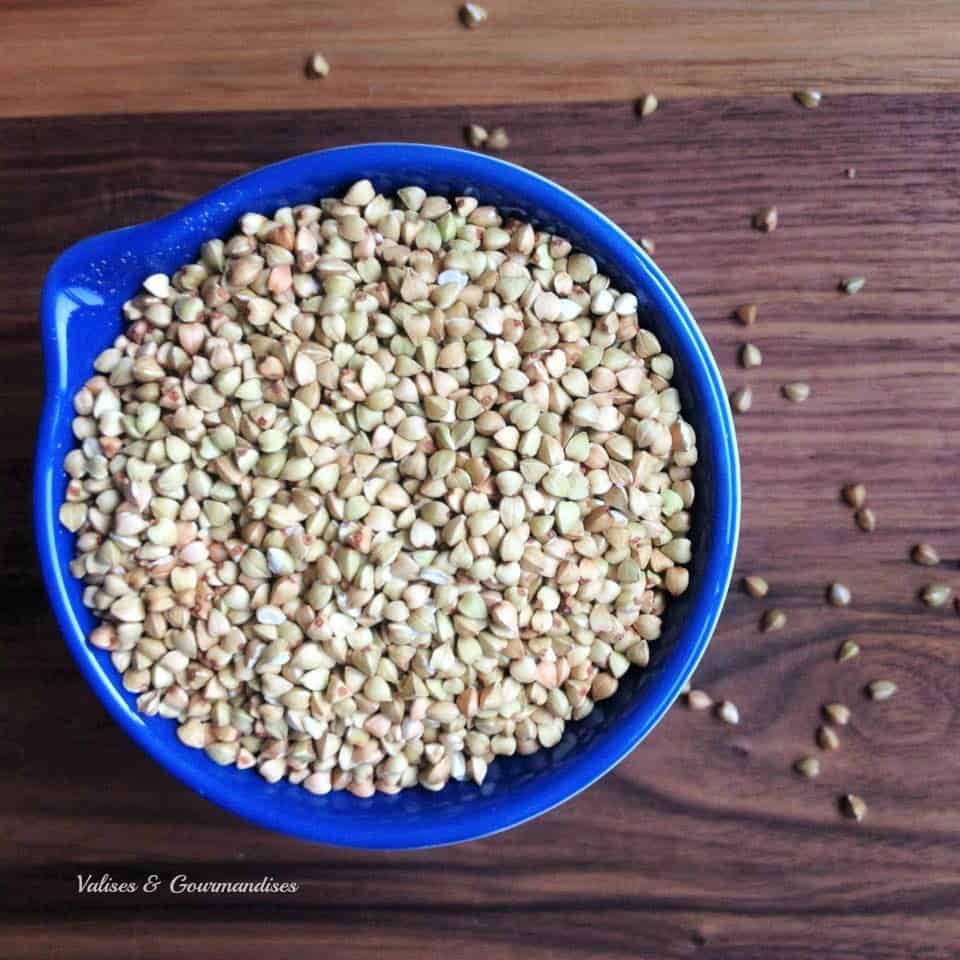
As for millet, it probably found a place in your kitchen a little before Christmas, with the now famous millet “meat” pie, a plant-based rendition of a Québec classic. Millet is also popular in veggie burgers and patties, but it can also be used to make porridge, as replacement for couscous or in a decadent Buddha bowl.
Tofu
Do you know how tofu is made? It simply consists of curdled soy milk that has been pressed in the shape of a block. It’s very interesting on a nutritional stand point and it comes in many different textures like dessert (which often contains a lot of added sugar), soft or silken (perfect for sauces, smoothies and desserts), semi-firm, firm, and extra-firm (all three are perfect for sautés or for oven cooking, amongst others), and in different flavours (plain, herbs, nuts, mango, maple…). It’s also a complete protein and a very good source of iron.
I choose organic plain tofu that I season depending on what I’m using it for. Soy is often under fire, among others regarding the fact that most cultures are GMO, which isn’t false, but this GMO soy is mainly fed to cattle. Oh the irony. The tofu you find in Québec’s grocery stores, for example, is often organic and has the label “no GMO”. And regarding the insinuations that soy causes breast cancer, it’s good to keep in mind that Asian populations have been consuming high amounts of unprocessed soy for millennia and that women living in rural China don’t even know what breast cancer is! What you should look out for however, are the processed soy by-products, such as the isolated protein found in most processed foods, which should be avoided anyway.
Not everyone will fall in love with tofu after the first bite. It took me a while before being able to fully appreciate it, so don’t throw the towel just yet! All you have to do is press it well to remove water before marinating it and then cooking it. For your first attempts, don’t be afraid to drown it in healthy sauce to better appreciate it, like this express peanut butter sauté.
Tempeh
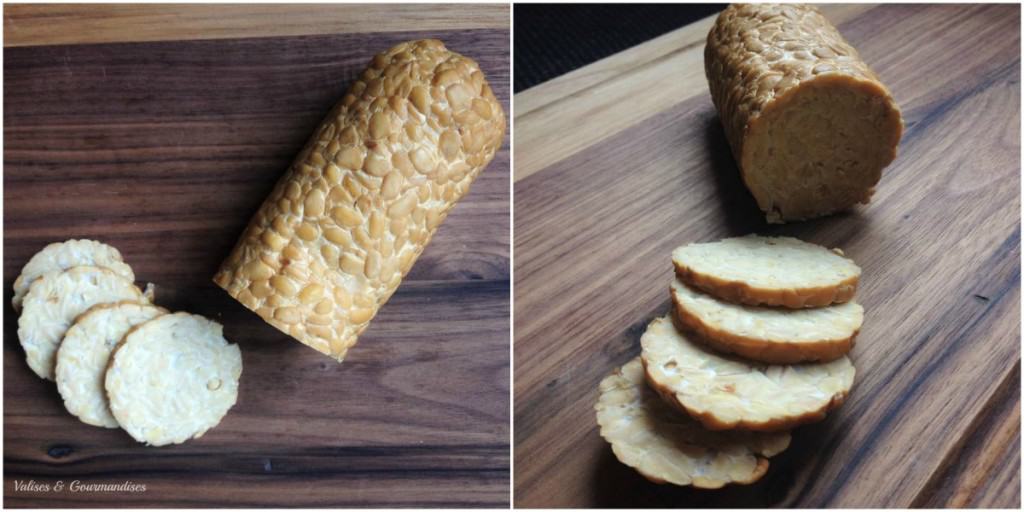
Nuts & seeds
For a long time, we believed that all fats were created equal and that nuts were to be avoided in fear of gaining weight. Well, studies on the matter are crystal clear: eating nuts contribute to our global health and even help weight loss.
I try to always keep the following varieties at home: almonds, cashew nuts, hazelnuts, Brazil nuts (for their selenium content) and walnuts. I also always have sunflower, pumpkin and sesame seeds, which all have a very interesting nutritional value!
How to use them: first, it’s best to choose raw organic and unsalted nuts, to munch on guilt-free or to add to homemade granola, etc. I also like to top my breakfasts and salads with a handful of nuts or seeds. Almonds and cashew, amongst others, are often used to create vegan cheese, sour cream or even cooking cream. As I mentioned previously, they also make delicious plant-based milks!
Dates & dried fruit
At first, I put dried dates under “sugars”, but after giving it some thought, they deserve their own section. After all, they helped desert civilizations to thrive by offering them fiber, antioxidants and, most importantly, lots of energy from their good carbs. Their delicate taste, reminiscent of caramel, is perfect to sweeten your recipes. I also like to golden raisins, mullberries, goji berries, dried apricots and figs!
How to use them: as is, as a snack, or cut and added to couscous or rice, or as a healthy sweetener for smoothies, or pulsed in a food processor with nuts and oats to make a raw pie crust or energy balls, soaked in water and puréed to sweeten desserts…
Sugars
Move over white refined sugar and corn syrup and make way for organic and non-refined alternatives: coconut sugar to replace brown sugar, raw cane sugar to replace white sugar, maple syrup, molasses, agave syrup, brown rice syrup, date sugar…
I’ve also realized that by almost completely removing processed foods from my diet, I need to add way less sugar and salt than before when I cook. I’ve learned to appreciate authentic tastes.
Oil and butter
I’ve tremendously reduced my consumption of added fat over the last two years. Most of the time I sauté my veggies in a little bit of water, I make oil-free salad dressings, I’ve stopped buttering up my toasts… When I do need some oil for my recipes, I go for cold-pressed extra-virgin olive oil, local canola oil also known as Mazola (perfect for cooking) and coconut oil (for its hard consistency at low temperature).
As for butter, there are many prepared plant-based versions available in grocery stores, but most of them contain palm oil and should be avoided. Earth Balance can easily be found in grocery stores and its palm oil is certified fair-trade and does not come from Indonesia. However, if you prefer to avoid palm oil altogether, Internet has many recipes for making your own “butter”. I still haven’t tried, but it’s on my never-ending to-do list!
And as for butter in baking, I’ve had great results using a 1:1 ratio of organic unsweetened apple sauce and coconut oil. These molasses cookies are the perfect example!
I also have to admit that I really like roasted sesame oil, which gives such a nice taste to Asian sauces and sautés.
Herbs and spices
For the longest time I thought that all there was to the spice department was cinnamon, dried parsley and salt & pepper, and that they really didn’t do anything else than add some flavour to our dishes. Boy was I wrong! Did you know that by sprinkling some cinnamon or dried oregano on your meal, you were boosting its antioxidant content!? Or that by adding a pinch of mustard powder to your cooked broccoli, you would be activating the anti-cancer properties normally lost during cooking!?
I couldn’t live without: turmeric, Cayenne pepper, Ceylon cinnamon, oregano, garlic powder, sea salt, black pepper
And very close behind are: curry, garam masala (there are many different variety, for example Moroccan Ras el hanout, or more Indian flavours), cumin, coriander, red pepper flakes, cardamom, nutmeg, allspice, bay leaves, onion powder, paprika, chili powder, basil, parsley
Good to have: mustard powder or grains, diverse herbs (sage, thyme, etc.)
Seaweeds
Seaweeds are not only delicious in salads (wakame) and sushi, they’re also a good superfood to add to your soups and salads to benefit from their numerous vitamins and minerals and to add an essential dose of iodine to your diet. I’m no expert though and I still have a lot to learn about them! For the moment, I simply buy organic nori sheets that I either use as is or that I shred and add into different recipes, incognito.
Pasta
Talking about pasta, it seems like every time I go to the organic shop, there’s a new healthy option, made out of whole wheat, quinoa, lentils, rice, black rice, buckwheat (Soba)… A lot of people avoid all noodles because they’re afraid of carbs, but you really don’t have anything to fear of these unrefined varieties!
Vinegars
There are many interesting vinegars out there, but I only have three at home: rice vinegar for Asian flavouring, as well as balsamic and apple cider vinegar.
How to use them: use them to bring out the flavours in vinaigrettes and sauces. Apple cider vinegar is also perfect for getting this cheesy taste in nut cheese. Add a spoonful to plant-based milk to make your own buttermilk. It’s also said to have many health properties, but I haven’t found anything quite convincing on the topic. If you can find it, choose an ACV that is raw and organic and that contains the mother, a living organism that provides probiotics and good bacteria!
Freezer
I always keep frozen spinach, which I add to sautés, soups, chilis, smoothies, etc. Veggie mixes are also a cheap and healthy option, perfect for busy weeknights.
I also like to have frozen organic bananas on hand for my famous homemade nice cream, as well as all sorts of frozen fruits for healthy desserts or smoothies.
Canned goods
Whole or diced tomatoes: for soups, curries, sauces…
Tomata passata: puréed tomatoes which are perfect for spaghetti sauce.
Coconut milk: for exotic casseroles such as curries, soups, for desserts, etc.
Varied beans: for soups, casseroles, sauces, salads, to make veggie burgers, etc. (see above)
Fruits & vegetables: I prefer them frozen than canned, but it can be hard to find frozen corn, litchis and other fruits. Choose cans with no added salt or sugar.
So guys, I know this post is very long, but I do hope it was helpful! Let me know if there’s anything you’d add or if you’d like me to write on other topics related to a plant-based diet or a vegan lifestyle!
Similar articles
**This article contains a few affiliate links, which means that I will receive a small commission if you purchase a product through them. The price remains the same for you, but this way you are helping me maintaining the blog and providing you more interesting content! :)

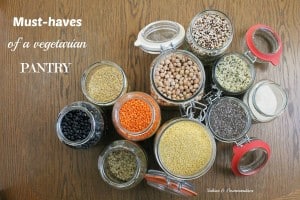
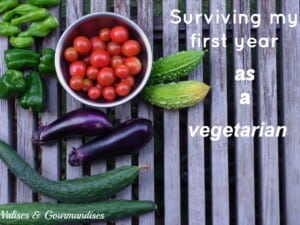
Hi Aryane! I really enjoyed this read! I can’t believe you wrote it in both French and English, haha, must have take a while :) I like the way you write, so it was fun and interesting at the same time ??? Thanks for sharing it! ?
Hey Tina! Thank you so much for your nice comment! I’m happy you liked it, do you think I forgot anything? :)
And yes, it took me forever to write, especially since we moved in between and I was out of a lot of stuff and couldn’t take any good pictures… haha #firstworldproblem right! Have a nice day! <3